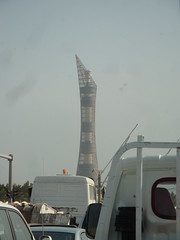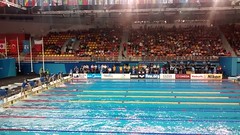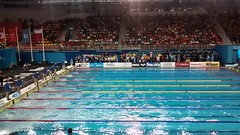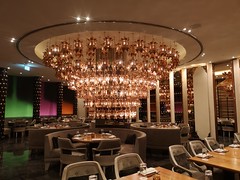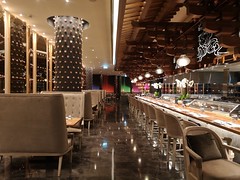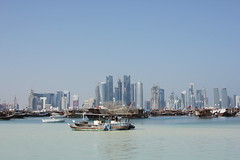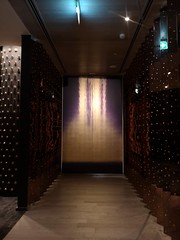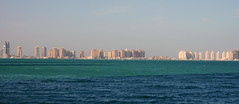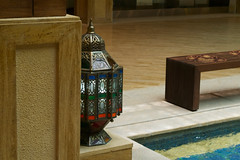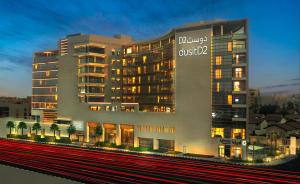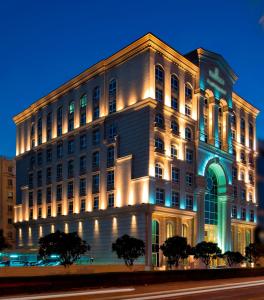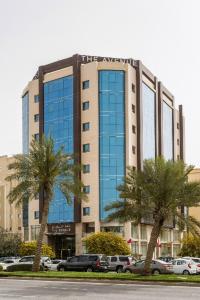 Qatar
Qatar
Qatar (English: /ˈkætˈkʌt-ˈgæt-ˈgʌt-kæˈtgæ-kə-/, English: /ˈktkəˈt/; Arabic: قطر Arabic: [ˈqɑtˤɑr]; local vernacular pronunciation: Arabic: [ˈɡɪtˤɑr]),!-- There seem to be a number of additional variants in sporadic use, but lets stick to those attested in pronunciation dictionaries, especially since CEPD and LPD concur almost entirely. --> officially the State of Qatar, is a country in Western Asia. It occupies the Qatar Peninsula on the northeastern coast of the Arabian Peninsula in the Middle East; it shares its sole land border with Saudi Arabia to the south, with the rest of its territory surrounded by the Persian Gulf. The Gulf of Bahrain, an inlet of the Persian Gulf, separates Qatar from nearby Bahrain. The capital is Doha, home to over 80% of the country's inhabitants, and the land area is mostly made up of flat, low-lying desert.
Qatar has been ruled as a hereditary monarchy by the House of Thani since Mohammed bin Thani signed a treaty with the British in 1868 that recognised its separate status. Following Ottoman rule, Qatar became a British protectorate in 1916, and gained independence in 1971. The current emir is Tamim bin Hamad Al Thani, who holds nearly all executive and legislative authority under the Constitution of Qatar, as well as controlling the judiciary. He appoints the prime minister and cabinet. The partially-elected Consultative Assembly can block legislation and has a limited ability to dismiss ministers.
In early 2017, the total population of Qatar was 2.6 million, with 313,000 of them Qatari citizens and 2.3 million expatriates. Its official religion is Islam. In terms of income, the country has the fourth-highest GDP (PPP) per capita in the world, and the eleventh-highest GNI per capita (Atlas method). Qatar ranks 42nd in the Human Development Index, the third-highest HDI in the Arab world. It is a high-income economy, backed by the world's third-largest natural gas reserves and oil reserves. Qatar is one of the world's largest exporters of liquefied natural gas, and the world's largest emitter of carbon dioxide per capita.
In the 21st century, Qatar emerged as a middle power in the Arab world through its resource-wealth, as well as its globally expanding media group, Al Jazeera Media Network, and reportedly supporting several rebel groups financially during the Arab Spring. Qatar forms part of the Gulf Cooperation Council. Qatar's human rights record has been regarded by academics and non-governmental organisations as being generally poor, with restrictions on civil liberties such as the freedoms of association, expression and the press, as well as its treatment of thousands of migrant workers amounting to forced labour for projects in the country.
Etymology
Pliny the Elder, a Roman writer, documented the earliest account pertaining to the inhabitants of the peninsula around the mid-first century AD, referring to them as the Catharrei, a designation that may have derived from the name of a prominent local settlement. A century later, Ptolemy produced the first known map to depict the peninsula, referring to it as Catara. The map also referenced a town named "Cadara" to the east of the peninsula. The term "Catara" (inhabitants, Cataraei) was exclusively used until the 18th century, after which "Katara" emerged as the most commonly recognised spelling. Eventually, after several variations — "Katr", "Kattar" and "Guttur" — the modern derivative Qatar was adopted as the country's name.
In Standard Arabic, the name is pronounced Arabic: [ˈqɑtˤɑr], while in the local dialect it is Arabic: [ˈɡɪtˤɑr].
English speakers use different approximate pronunciations of the name as the Arabic pronunciations use sounds not often used in English.
History
Antiquity
Human habitation in Qatar dates back to 50,000 years ago. Settlements and tools dating back to the Stone Age have been unearthed in the peninsula. Mesopotamian artifacts originating from the Ubaid period (c. 6500–3800 BC) have been discovered in abandoned coastal settlements. Al Da'asa, a settlement located on the western coast of Qatar, is the most important Ubaid site in the country and is believed to have accommodated a small seasonal encampment.
Kassite Babylonian material dating back to the second millennium BC found in Al Khor Islands attests to trade relations between the inhabitants of Qatar and the Kassites in modern-day Bahrain. Among the findings were 3,000,000 crushed snail shells and Kassite potsherds. It has been suggested that Qatar is the earliest known site of shellfish dye production, owing to a Kassite purple dye industry which existed on the coast.
In 224 AD, the Sasanian Empire gained control over the territories surrounding the Persian Gulf. Qatar played a role in the commercial activity of the Sasanids, contributing at least two commodities: precious pearls and purple dye. Under the Sasanid reign, many of the inhabitants in Eastern Arabia were introduced to Christianity following the eastward dispersal of the religion by Mesopotamian Christians. Monasteries were constructed and further settlements were founded during this era. During the latter part of the Christian era, Qatar comprised a region known as 'Beth Qatraye' (Syriac for "house of the Qataris"). The region was not limited to Qatar; it also included Bahrain, Tarout Island, Al-Khatt, and Al-Hasa.
In 628, the Islamic prophet Muhammad sent a Muslim envoy to a ruler in Eastern Arabia named Munzir ibn Sawa Al Tamimi and requested that he and his subjects accept Islam. Munzir obliged his request, and accordingly, most of the Arab tribes in the region converted to Islam. In the middle of the century, the Muslim conquest of Persia would result in the fall of the Sasanian Empire.
Early and late Islamic period (661–1783)
Qatar was described as a famous horse and camel breeding centre during the Umayyad period. In the 8th century, it started benefiting from its commercially strategic position in the Persian Gulf and went on to become a centre of pearl trading.
Substantial development in the pearling industry around the Qatari Peninsula occurred during the Abbasid era. Ships voyaging from Basra to India and China would make stops in Qatar's ports during this period. Chinese porcelain, West African coins, and artefacts from Thailand have been discovered in Qatar. Archaeological remains from the 9th century suggest that Qatar's inhabitants used greater wealth to construct higher quality homes and public buildings. Over 100 stone-built houses, two mosques, and an Abbasid fort were constructed in Murwab during this period. When the caliphate's prosperity declined in Iraq, so too did it in Qatar. Qatar is mentioned in 13th-century Muslim scholar Yaqut al-Hamawi's book, Mu'jam Al-Buldan, which alludes to the Qataris' fine striped woven cloaks and their skills in improvement and finishing of spears.
Much of Eastern Arabia was controlled by the Usfurids in 1253, but control of the region was seized by the prince of Ormus in 1320. Qatar's pearls provided the kingdom with one of its main sources of income. In 1515, Manuel I of Portugal vassalised the Kingdom of Ormus. Portugal went on to seize a significant portion of Eastern Arabia in 1521. In 1550, the inhabitants of Al-Hasa voluntarily submitted to the rule of the Ottomans, preferring them to the Portuguese. Having retained a negligible military presence in the area, the Ottomans were expelled by the Bani Khalid tribe and their emirate in 1670.
Bahraini and Saudi rule (1783–1868)
In 1766, members of the Al Khalifa family of the Utub tribal confederation migrated from Kuwait to Zubarah in Qatar. By the time of their arrival, the Bani Khalid exercised weak authority over the peninsula, notwithstanding the fact that the largest village was ruled by their distant kin. In 1783, Qatar-based Bani Utbah clans and allied Arab tribes invaded and annexed Bahrain from the Persians. The Al Khalifa imposed their authority over Bahrain and retained their jurisdiction over Zubarah.
Following his swearing-in as crown prince of the Wahhabi in 1788, Saud ibn Abd al-Aziz moved to expand Wahhabi territory eastward towards the Persian Gulf and Qatar. After defeating the Bani Khalid in 1795, the Wahhabi were attacked on two fronts. The Ottomans and Egyptians assaulted the western front, while the Al Khalifa in Bahrain and the Omanis launched an attack against the eastern front. Upon being made aware of the Egyptian advance on the western frontier in 1811, the Wahhabi amir reduced his garrisons in Bahrain and Zubarah in order to redeploy his troops. Said bin Sultan, ruler of Muscat, capitalised on this opportunity and raided the Wahhabi garrisons on the eastern coast, setting fire to the fort in Zubarah. The Al Khalifa was effectively returned to power thereafter.
As punishment for piracy, an East India Company vessel bombarded Doha in 1821, destroying the town and forcing hundreds of residents to flee. In 1825, the House of Thani was established with Sheikh Mohammed bin Thani as the first leader.
Although Qatar was considered a dependency of Bahrain, the Al Khalifa faced opposition from the local tribes. In 1867, the Al Khalifa, along with the ruler of Abu Dhabi, sent a massive naval force to Al Wakrah in an effort to crush the Qatari rebels. This resulted in the maritime Qatari–Bahraini War of 1867–1868, in which Bahraini and Abu Dhabi forces sacked and looted Doha and Al Wakrah. The Bahraini hostilities were in violation of the Perpetual Truce of Peace and Friendship of 1861. The joint incursion, in addition to the Qatari counter-attack, prompted British Political Resident, Colonel Lewis Pelly to impose a settlement in 1868. His mission to Bahrain and Qatar and the resulting peace treaty were milestones because they implicitly recognised the distinctness of Qatar from Bahrain and explicitly acknowledged the position of Mohammed bin Thani. In addition to censuring Bahrain for its breach of agreement, Pelly negotiated with Qatari sheikhs, who were represented by Moham…
Hotels Qatar
Looking for places related to Qatar?
Those are other destinations to find places related to Qatar:


